Rank Species | Phylum Chordata Genus ScopusBrisson, 1760 | |
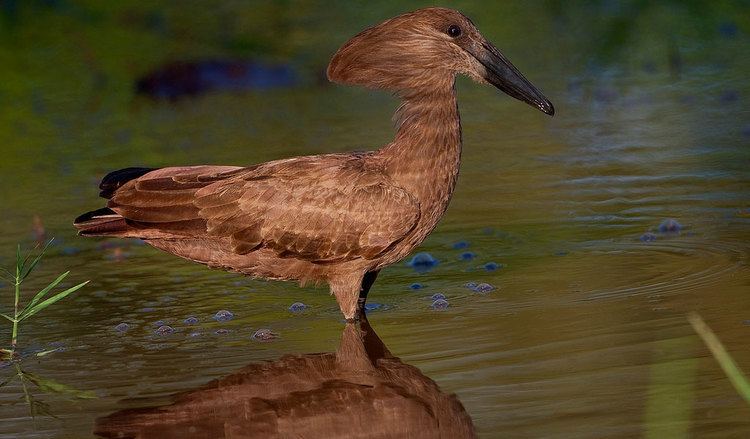 | ||
Family ScopidaeBonaparte, 1849 Similar | ||
The hamerkop (Scopus umbretta), also known as hammerkop, hammerkopf, hammerhead, hammerhead stork, umbrette, umber bird, tufted umber, or anvilhead, is a medium-sized wading bird 56 centimetres (22 in) in length with a weight of 470 grams (17 oz). The shape of its head with a long bill and crest at the back is reminiscent of a hammer, hence its name. It ranges from Africa, Madagascar to Arabia, in wetlands of a wide variety, including estuaries, lakesides, fish ponds, riverbanks and rocky coasts in Tanzania. The hamerkop, which is a sedentary bird that often show local movements, is not globally threatened and is locally abundant in Africa and Madagascar.
Contents
- Hamerkop scopus umbretta hammerhead 2013 04 27
- Taxonomy and systematics
- Subspecies
- Description
- Distribution and habitat
- Behaviour and ecology
- Breeding
- Food and feeding
- In culture
- References

Hamerkop scopus umbretta hammerhead 2013 04 27
Taxonomy and systematics

The hamerkop is usually included in the Ciconiiformes, but might be closer to the Pelecaniformes. It constitutes a family (Scopidae) and genus (Scopus) all on its own because of its unique characteristics.
Subspecies
There are two subspecies, Scopus umbretta umbretta and Scopus umbreta minor.

Description
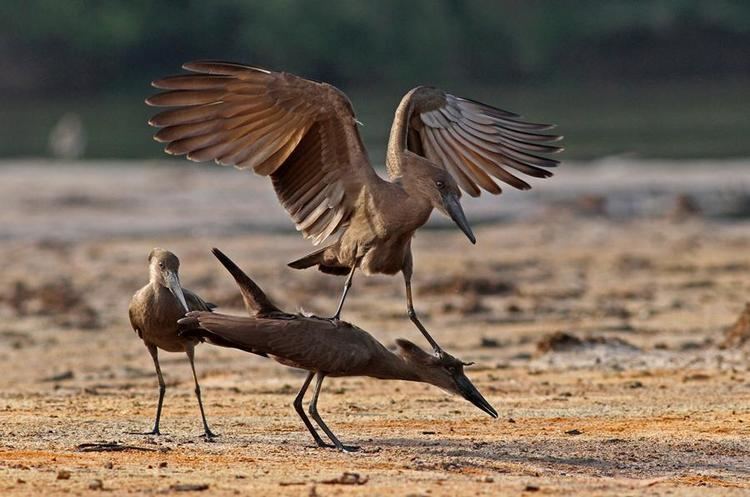
Its plumage is a drab brown with purple iridescence on the back (the subspecies S. u. minor is darker). The bill is long, flat, and slightly hooked. The neck and legs are shorter than those of most of the Ciconiiformes. The hamerkop has, for unknown reasons, partially webbed feet. The middle toe is comb-like (pectinated) like a heron's. Its tail is short and its wings are big, wide, and round-tipped; it soars well. When it does so, it stretches its neck forward like a stork or ibis, but when it flaps, it coils its neck back something like a heron.
Vocalisations include cackles and a shrill call given in flight. Hamerkops are mostly silent except when in groups.
Distribution and habitat
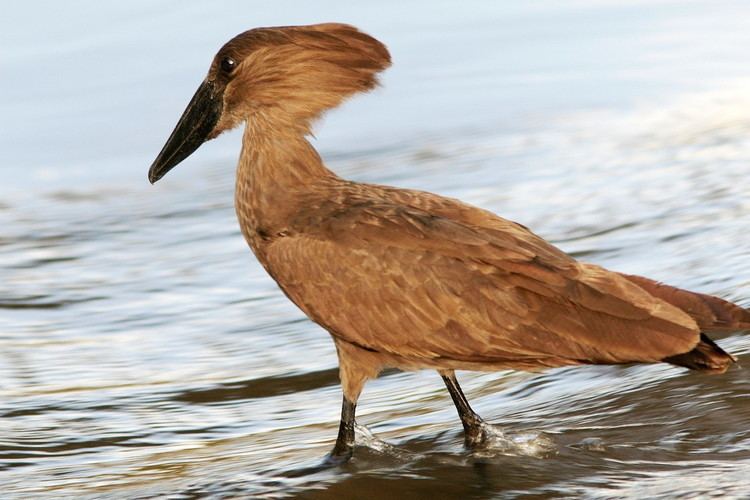
The hamerkop occurs in Africa south of the Sahara, Madagascar and coastal south-west Arabia in all wetland habitats, including irrigated land such as rice paddies, as well as in savannahs and forests. Most are sedentary within their territories, which are held by pairs, but some migrate into suitable habitat during the wet season only. Whenever new bodies of water are created, such as dams or canals, hamerkops quickly move in.
Behaviour and ecology
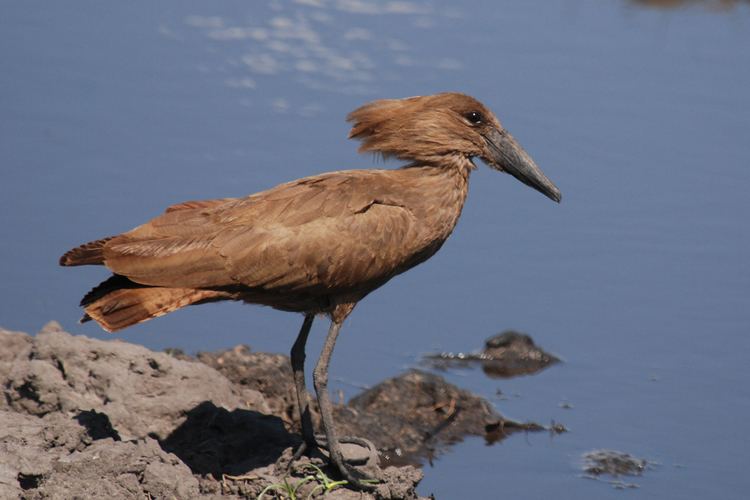
The hamerkop's behaviour is unlike other birds. One unusual feature is that up to ten birds join in "ceremonies" in which they run circles around each other, all calling loudly, raising their crests, fluttering their wings. Another is "false mounting", in which one bird stands on top of another and appears to mount it, but they may not be mates and do not copulate.
Breeding
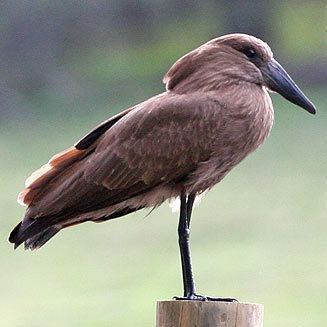
The strangest aspect of hamerkop behaviour is the huge nest, sometimes more than 1.5 metres (4 ft 11 in) across, comprising perhaps 10,000 sticks and strong enough to support a man's weight. The birds decorate the outside with any bright-coloured objects they can find. When possible, they build the nest in the fork of a tree, often over water, but if necessary they build on a bank, a cliff, a human-built wall or dam, or on the ground. A pair starts by making a platform of sticks held together with mud, then builds walls and a domed roof. A mud-plastered entrance 13–18 centimetres (5.1–7.1 in) wide in the bottom leads through a tunnel up to 60 centimetres (24 in) long to a nesting chamber big enough for the parents and young.
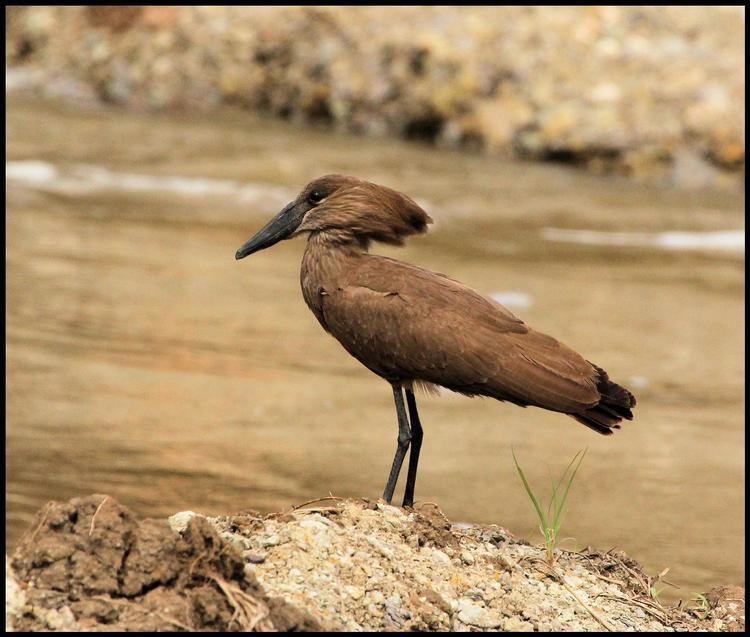
These birds are compulsive nest builders, constructing three to five nests per year whether they are breeding or not. Barn owls and eagle owls may force them out and take over the nests, but when the owls leave, the hamerkops may reuse the nests. Snakes, small mammals such as genets, and various birds live in abandoned nests, and weaver birds, starlings, and pigeons may attach their nests to the outside.
At the finished nest, a pair gives displays similar to those of the group ceremonies and mates, often on top of the nest. The clutch consists of three to seven eggs which start white but soon become stained. Both sexes incubate for 28 to 30 days. Both feed the young, often leaving them alone for long times; this unusual habit for wading birds may be made possible by the thick nest walls. The young hatch covered with grey down. By 17 days after hatching, their head and crest plumage is developed, and in a month, their body plumage. They leave the nest at 44 to 50 days but roost in it at night until about two months after hatching.
Food and feeding
Hamerkops feed during the day, often taking a break at noon to roost. They normally feed alone or in pairs. The food is typical of long-legged wading birds, and the most important is amphibians. They also eat fish, shrimp, insects and rodents. They walk in shallow water looking for prey, shuffling one foot at a time on the bottom or suddenly opening their wings to flush prey out of hiding. The same shuffling technique is used to locate food in middens of fish remains.
In culture
There are many legends about the hamerkop. In some regions, people state that other birds help it build its nest. The ǀXam informants of Wilhelm Bleek said that when a hamerkop flew and called over their camp, they knew that someone close to them had died.
It is known in some cultures as the lightning bird, and the Kalahari Bushmen believe or believed that being hit by lightning resulted from trying to rob a hamerkop's nest. They also believe that the inimical god Khauna would not like anyone to kill a hamerkop. According to an old Malagasy belief, anyone who destroys its nest will get leprosy, and a Malagasy poem calls it an "evil bird". Such beliefs have given the bird some protection.
Scopus, a database of abstracts and citations for scholarly journal articles, received its name in honour of this bird, as the hamerkop is renowned for its superior navigation skills.
